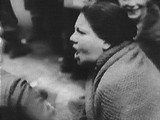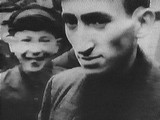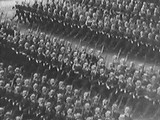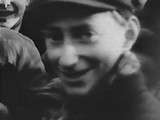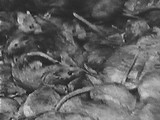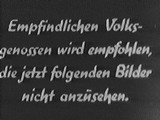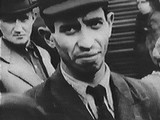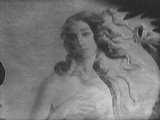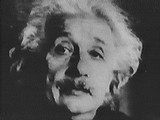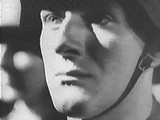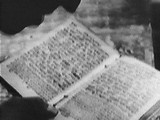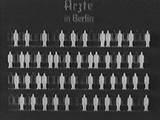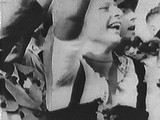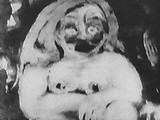|
43. "Der ewige Jude" contained nothing new,
but was virtually a filmed "black book" filled with examples from many
years of anti-Semitic traditions. As part of the propaganda set-up -
and as with all feature films of the day - one could purchase an
illustrated program, the Illustrierte Film-Kurier, with a summary of
the contents of the film which is reprinted here in order to give an
impression of this the hate-film of all time:
The film begins with an impressive expedition through the Jewish
ghettoes in Poland. We are shown Jewish living quarters, which in our
view cannot be called houses. In these dirty rooms lives and prays a
race, which earns its living not by work but by haggling and swindling.
From the little urchin to the old man, they stand in the streets,
trading and bargaining. Using trick photography,
we are shown how the
Jewish racial mixture in Asia Minor developed and flooded the entire
world. We see a parallel to this in the itinerant routes of rats, which
are the parasites and bacillus-carriers among animals, just as the Jews
occupy the same position among mankind. The Jew has always known how to
assimilate his external appearance to that of his host. Contrasted are
the same Jewish types, first the Eastern Jew with his kaftan, beard,
and sideburns, and then the clean-shaven, Western European Jew. This
strikingly demonstrates how he has deceived the Aryan people. Under
this mask he increased his influence more and more in Aryan nations and
climbed to higher-ranking positions. But he could not change his inner
being.
After the banishment of the Jews from Europe was lifted, following
the age of Enlightenment, the Jew succeeded within the course of several
decades in dominating the world economy, before the various host
nations realized - and this despite the fact that they made up only 1
per cent of the world population. An excerpt from an American film
about the Rothschilds, made by Jews, reveals to us the cunning
foundations of their banking empire. Then we see how Jews, working for
their international finance, drive the German people into the November
Revolution. They then shed their anonymity and step out openly on to
the stage of political and cultural life. Thus the men who were
responsible for the disgraceful debasement of the German people are
paraded before us. Incontestable examples are shown of how they robbed
the country and the people of immense sums. As well as gaining
financial supremacy they were able to dominate cultural life. The
repulsive pictures of so-called Jewish "art"
reveal the complete
decline of cultural life at that time. Using original sequences from
contemporary films, the degrading and destructive tendency of Jewish
power is exposed. For hundreds of years German artists have glorified
figures from the Old Testament, knowing full well the real face of
Jewry. How the Jew actually looks like is shown in scenes shot by Jews
themselves in a "culture film" of a Purim festival, which is still
celebrated today to commemorate the slaughter of 75,000 anti-Semitic
Persians, and the doctrine with which future Rabbis in Jewish schools
are educated to be political pedagogues. We look into a Jewish 'Talmud'
class and experience the oriental tone of the ceremony in a Jewish
synagogue, where Jews conduct business deals among themselves during
the holy services.
However, the cruel face of Judaism is most brutally displayed in the
final scenes, in which original shots of a kosher butchering are
revealed. These film documents of the inhuman slaughter of cattle and
sheep without anaesthesia provide conclusive evidence of a brutality
which is simply inconceivable to all Aryan people. In shining contrast,
the film closes with pictures of German people and German order which
fill the viewer with a feeling of deep gratification for belonging to a
race whose Führer is fundamentally solving the Jewish problem.
44. The evidence is circumstancial, but this
date is the only one that interlocks with the logic of the film
production and with the psychological pattern of Hitler's behaviour.
From an entry in Goebbels' diary on May 9, 1940, we know that he is
still working on the final cut. Froehlich (note 16), vol. 4, p. 150-51.
We know from the same diary, that he sent a transportable projector to
Hitler's Field Headquarters because he considered it important for his
activities as a propaganda minister that Hitler at least could see the
news-reels. Entry from May 12, 1940, Froehlich 16 vol. 4, p. 156. In the following days
Goebbels does not refer to "Der ewige Jude" in his diary, but on May 23
he suddenly informed his staff that he was satisfied with the film in
its present version. Willi A. Boelcke (ed.): Kriegspropaganda
1939-1941. Geheime Ministerkonferenzen im Reichspropagandaministerium.
Stuttgart 1966, p. 487. It was the first time that "Der ewige Jude" is
mentioned officially in the protocol of the secret conferences and it
can only mean that Hitler must have approved it before this date.
Another indication of an approval on May 20 might be the fact that the
earliest hint towards a future campaign against Jewish-Bolshevik Russia
was a remark from Hitler to general Halder on May 21. Klaus Hildebrand:
Deutsche Aussenpolitik. Kalkuel oder Dogma? Stuttgart 1990, p. 99.
45. Cf. note 27.
46. Froehlich 16 vol. 4, p. 315.
47. Boelcke 44 pp. 503 and 518.
48. Interview printed in three German film
magazines: Der Film No. 48/1940; Film-Kurier No. 279/1940; Filmwelt No.
49/1940. Reprinted in the author's source-critical edition 20 pp. 309-12.
49. M. Domarus (ed.): Hitler. Reden und
Proklamationen. Wuerzburg 1962. Vol. 2, p. 1663.
50. C.C. Aronsfeld: "'Perish Judah'. Nazi
Extermination Propaganda 1920-1945. Pattern of Prejudice 12,5 (1978),
pp. 22-23.
51. During the summer of 1992 I closely
followed Serbian and Croate Television live on Cable-TV. My experiences
from viewing these programs as well as the whole mix of programs
finally made me leave my original working hypothesis and to accept "Der
ewige Jude" as a crucial factor for instigating the Holocaust.
52. This interpretation is supported by three
further arguments: 1) Goebbels would never have dared to present a film
on such a key issue in Nazi ideology to the public without the explicit
approval by the Führer. 2) In 1940 all visual representation of
the Führer had to be approved by him personally. 3) The
significance of the Führer-Myth and the way Hitler was presented
to the German public by means of documentary footage is documented
through the SD-report from November 28, 1940 (the opening night of "Der
ewige Jude"), commenting on the news-reels: "There is still an
overwhelming interest for all shots of the Führer. It is almost so
that a news-reel without pictures of the Führer is not regarded as
a proper news-reel. One wishes all the time to see what he looks like,
whether he is grave or laughs. On the other hand one is deeply
disappointed that for a long time one has not been able to hear his
voice in the news-reels, too." - Heinz Boberach: Meldungen aus dem
Reich. Neuwied-Berlin 1965, p. 114f.
53. Cf. Froehlich 16, vol. 4, 192.
54. Bundesarchiv-Militärarchiv Freiburg.
RW 47/6. Kriegstagebuch des Kommandanten Führerhauptquartier.
Entry from June 1, 1940, shows that Hitler visited Wervicq that
afternoon after having visited other sites of WW1. His photographer
Heinrich Hoffmann took nine photos on that occasion. Fotoarchiv
Hoffmann, Bayerische Staatsbibliothek, Muenchen. File XVI. 39.
55. Adolf Hitler: Mein Kampf. 681-685.
Auflage. Muenchen 1942, pp. 220-21.
56. Mein Kampf 55 pp. 222-25.
57. Rudolph Binion: "... dass ihr mich
gefunden habt." Hitler und die Deutschen: Eine Psychoanalyse. Stuttgart
1978. In an appendix (p. 178-81) Binion has collected many sources of
how Hitler himself described what happened in Pasewalk.
58. From my reading as a layman of modern
research on Post Traumatic Stress Disorder - using the excellent
library of the International Research and Rehabilitation Center for
Torture Victims in Copenhagen - it seems to be a very fruitful
hypothesis to regard Adolf Hitler as a person suffering from a
potential PTSD and to use modern knowledge on this condition as the
structural explanation of the development of his personality. The
doctor that treated him in Pasewalk described him as being hysterical
because of a shell shock, which was the way PTSD was diagnosed at that
time. - This approach might also point to the reason why Adolf Hitler
hated the Jews - and not the English who had sent the shell that
blinded him. Brigitte Hamann has recently shown that when Hitler left
Vienna in Spring 1913, he had not yet become a fanatic anti-Semite,
although his impressions from Vienna later became part of the reasoning
behind his anti-Semitism. Brigitte Hamann: Hitlers Wien. Lehrjahre
eines Diktators. Muenchen 1996. Therefore we have to search a personal
experience with a Jew during the war to be the key event which at the
outbreak of the trauma made him believe that he himself was responsible
for the German defeat: He had committed a sin because he had violated
German spirit by carrying out the wish of a Jew and therefore he
himself had to redeem it by fighting the Jews. From a semiotic point of
view it is possible to put forward the following scenario: Hitler's
immediate superior from January 31 to August 30, 1918, was a Jewish
officer, named Hugo Gutmann. Gutmann promised Hitler Iron Cross 1st
Class, if he was successful in getting an important message through
during heavy fighting in late May. It was months later - on August 4,
1918 - that Hitler got the award which later became the token of his
life, but only four days later - at a time when Gutmann was on leave -
that the German army had to retreat, and Gutmann was shortly after
transferred to a post far behind the lines, while Hitler stayed and got
wounded. Strangely enough, Hitler never told anybody why he was
awarded, although one could assume that this could have been
instrumental in his efforts to gain political support. Hitler, however,
referred once explicitly to Gutmann, namely in his table-talks on
November 10, 1941. Jochmann, Werner (ed.): Adolf Hitler. Monologe im
Führerhauptquartier 1941-1944. Die Aufzeichnungen Heinrich Heims.
Hamburg 1980, p. 132. The date here is important, as his curse on
Gutmann took place on the anniversary of his trauma - and coincides
with the date where Himmler was put so much under pressure by Hitler
that he told Kersten about the order to kill the Jews.
59. Yehuda Bauer: Freikauf von Juden?
Verhandlungen zwischen dem nationalsozialistischen Deutschland und
juedischen Repräsentanten von 1933 bis 1945. Franfurt/Main 1996,
p. 97.
60. Karl Klee: Das Unternehmen 'Seeloewe'.
Goettingen 1958, p. 189f.
61. Uwe Dietrich Adam: Judenpolitik im Dritten
Reich. Tuebingen 1972, pp. 273-85.
62. Adam 61
p. 245 with note 59.
63. Kommandotagebuch 54. Entry from June 6, 1940.
64. Kommandotagebuch 54. Entry from June 13, 1940. The
implications of this name was clearly understood by the Staff of the
Army which started to work out plans for the campaign without having a
specific order. - Hitler's pattern of symbolic behaviour during this
period is also confirmed by other events. On the morning after the
capitulation of France Hitler paid a visit to Napoleon's grave in Paris
and, so to speak, took over the task of fighting Russia, which Napoleon
had invaded on June 22, 1812. It was, therefore, no coincidence that
the final battle against the Jews was launched on June 22, 1941. It was
exactly one year after he had ordered Himmler to be responsible for
exterminating the Jews.
65. Just as Hitler turned the village of his
father (whom he hated because of the possibility of having a Jewish
grandfather) into a training field for the Wehrmacht, he "erased" the
site where he had obtained his Iron Cross 1st Class by installing a new
Field Headquarters. He called it "Wolfsschlucht 2," a fact, which could
be considered as another indication of Gutmann's importance to the
exterminist character of Hitler's anti-Semitism.
66. Felix Kersten: Totenkopf und Treue.
Heinrich Himmler ohne Uniform. Aus den Tagebuechern des finnischen
Medizinalrats. Hamburg 1952, p. 149. Kersten is a disputed source among
historians, because he is overestimating his own influence upon
history. Richard Breitman choose to disregard him in his important book
The Architect of Genocide. Himmler and the Final Solution. London 1991.
Yehuda Bauer has on the other hand underlined that there always seems
to be some truth in the factual information, that Kersten relates. See
Bauer 58 p. 166-67. Gerald Fleming,
who has himself studied Kersten, in a letter to me has stressed that
Kersten can be used as a source, if he is double-checked. The main
reason for me to believe in Kersten on this particularly point is the
date, he gives for his entry: November 11, 1941. This date would
account for the reason why Himmler suffered that much from
psychosomatic stomach cramps that he told Kersten. It was the day after
Hitler had cursed Gutmann, and Himmler's stomach problems could have
derived from a rebuke from Hitler for not being efficient enough.
67. Kersten 66 p. 200.
68. Cf. Bradley F. Smith/Agnes F. Peterson
(ed.): Heinrich Himmler: Geheimreden 1933-1945 und andere Aussprachen.
Frankfurt/Main 1974.
69. Richard Breitman 66 argues that Himmler started the
preparations for the Holocaust in the summer of 1940 on his own.
Although I disagree on this point, I consider his book to be an
excellent and well-documented analysis of Himmler's crucial role in
actually carrying out Hitler's order which in details interlocks with
the chronology of the decision-making process presented in this paper.
70. Breitman 66 p. 124.
71. Helmut Krausnick: "Denkschrift Himmlers
ueber die Behandlung der Fremdvoelkischen im Osten (Mai 1940)."
Vierteljahrshefte fuer Zeitgeschichte 5 (1957), p. 194-98. Breitman
66 p. 127.
72. Helmut Krausnick: "Hitler und die Morde in
Polen." Vierteljahrshefte fuer Zeitgeschichte 11 (1963), p. 207
73. Karl Hueser: Wewelsburg 1933 bis 1945.
Kult- und Terrorstätte der SS. Paderborn 1982, p. 274.
74. In the author's Danish book 1 there is a detailed argumentation for this
claim.
75. Lucy S. Dawidowicz: Der Krieg gegen die
Juden 1933-1945. Muenchen 1975, p. 175.
76. Cf. Breitman 66 pp. 116-44.
77. On September 30, 1940, Himmler ordered the
SS and the police to see "Jud Süß" during the winter. Hollstein
27 p. 106. No such order was
neccessary with relevance to "Der ewige Jude," because it was produced
by the state itself - and not by a private company. Therefore there
were no expenses connected with the presentation of "Der ewige Jude"
which were the case when showing "Jud Süß."
78. There were also produced a Dutch, a French
and an international version of "Der ewige Jude." Cf. the author's
source-critical edition 20, p. 305.
79. Mein Kampf 55 pp. 649-69.
80. Adalbert Rueckerl: Nationalsozialistische
Vernichtungslager im Spiegel deutscher Strafprozesse. Muenchen 1979, pp.
256-57.
81. Cf. the author's source-critical edition
20 with its shot-to-shot analysis.
82. Stig Hornshøj-Møller:
"Kultfilm der Neonazis. 'Der ewige Jude' verbreitet immer noch 24
Luegen pro Sekunde." medium 3/1994, p. 31-33. Michael Schmidt: Heute
gehoert uns die Strasse. Der Inside-Report aus der Neonazi-Szene.
Duesseldorf 1994, p. 47-52. - A video-copy of "Der ewige Jude" with an
American voice-over can be obtained from International Historic Films,
Box 29035, Chicago, Illinois 60629, USA.
83. To quote the Minister of Information of
the Federal Republic of Yugoslavia, Slobodan Ignjatovic, in a
television interview from 1993: "We avoided showing atrocities and
genocide committed by the Croatians and Moslems against the Serbian
people - except when we had no other choice..." Video-copy in the
archive of the author.
84. Israel W. Charny: "Genocide and Mass
Destruction: Doing Harm to Others as a Missing Dimension in
Psychopathology." Psychiatry Vol. 49 (1986), pp. 144-57.
85. Everett C. Hughes: "Good People and Dirty
Work." In: Howard S. Becker (ed.): The Other Side. New York 1964, pp.
23-36.
86. Michael Ley: Genozid und Heilserwartung.
Zum nationalsozialistischen Mord am europäischen Judentum. Wien
1993.
87. Zygmunt Bauman: Modernity and the
Holocaust. Cambridge 1989.
88. Eric Markusen and David Kopf: The
Holocaust and Strategic Bombing: Genocide and Total War in the
Twentieth Century. Boulder 1995.
| 

